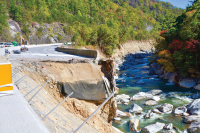Limestone ‘sink’ is just over the mountain

Editor’s note: This article first appeared in a January 2005 edition of The Smoky Mountain News.
“If it form the one landscape that we …
Are consistently homesick for, this is chiefly
Because it dissolves in water …
What I hear is the murmur of underground streams,
what I see is a limestone landscape.”
Related Items
— “In Praise Of Limestone,“ W.H. Auden (May 1948)
The topography and vegetation here in our part of Western North Carolina is among the most varied and attractive in North America. Most all of the distinctive natural features of the southern highlands — from spruce-fir and upland hardwood coves to highland bogs, escarpment gorges, and grassy balds — can readily be sought out and explored here in the far southwestern counties of the state.
But, alas, one sort of terrain we do, for the most part, lack is a true limestone or “karst” landscape. “Karst” is the term geologists apply to a landscape composed of soft, soluble limestone materials that have been “carved” by water and other natural processes into features such as caves, interconnected caverns, blow holes, bluffs, solution channels, and sinkholes. It’s the landscape of the Shenandoah Valley in Virginia, east Tennessee and northeast Alabama.
We do, of course, have some few caves and blow holes, especially in the Nantahala Gorge where limestone materials have been crystallized into dolomite and marble. This is the northern tip of the Murphy Marble Belt, which comes up out of Georgia in a giant northeastern-tending crescent. But the rocks here are too hard and limited in extent to have formed a true “karst” landscape.
To find such terrain we need to go just over the high divide between WNC and east Tennessee into the Cades Cove section of the Great Smoky Mountains National Park. During the mountain-building processes that created the Appalachians about 250 million years ago, older Precambrian rocks overrode more recently formed sea-deposited limestone. Accordingly, when you’re up on Clingmans Dome or Mt. LeConte or any of the other mountaintops here in WNC, you are standing on old hard stuff. You have to descend down into the coves along the western border of the park into what the geologists call “windows” to get to the softer, more soluble materials.
One of the most notable and little-visited of these “windows” is the Whiteoak Sink situated northwest of Cades Cove near Townsend on the park’s border. To get there, drive just over 21 miles south along the Little River road from the Sugarlands Visitors Center near Gatlinburg to the Schoolhouse Gap trailhead on the right (west) side of the highway.
The two-mile walk up to Schoolhouse Gap is very moderate over a gradually ascending jeep track. At the gap, veer sharply down the ridge to the left through a rhododendron tunnel that traverses a boggy gulch. As it’s dimly lit and the peaty bog forms pools seemingly going nowhere, it’s kind of spooky along this section of the trail.
A “sink” is a geological term applied to “a large depression caused by collapse of the ground into an underlying limestone cavern.” That’s exactly how Whiteoak Sink was formed perhaps two million years ago. But the term “sink” is also very descriptive of the way the creeks running down into this immense limestone basin vanish like the water going down the kitchen sink.
Have faith, and presently — after a 10-minute walk-scramble — you’ll enter into the flat basin of the sink, which is perhaps half a mile long and a quarter mile wide. Vertical limestone bluffs of up to 80 feet are visible during the winter months.
In summer, the entire flat is covered with a dense jungle of vegetation. It’s said that pioneer families who lived in the area kept cattle “in the sink,” and it certainly appears to be a good spot for foraging livestock in summer and sheltering them from the elements in winter.
Blowing Cave — a three-by-six foot opening — is the kitchen sinkhole of Whiteoak Sink. In times of extreme runoff, waters ultimately flow over a small waterfall down into the cave opening and adjacent areas under the high limestone bluff into the some dark underworld. I haven’t encountered anyone who knows where they emerge. The very last thing on my agenda — as it should be on yours — would be trying to find out. Always remember that you must obtain a permit from park authorities before entering any cave in the Great Smoky Mountains National Park.
In a karst landscape one encounters a situation unlike most others here in the southern highlands. This basement habitat seems light years away from the vistas and blue skies of the high spruce-fir country. But, in reality, it’s simply a remote patch in the varied mosaic of natural areas that makes this region so exciting to explore and piece together.
(Note: For additional information, see Harry L. Moore’s A Roadside Guide to the Great Smoky Mountains National Park.)
(George Ellison is a naturalist and writer. He can be reached at This email address is being protected from spambots. You need JavaScript enabled to view it..)









